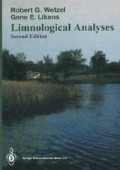Abstract
Earlier discussions emphasized that dead organic matter, called detritus, exists as a spectrum from dissolved organic compounds, organic colloids, and larger particles of organic matter. Dissolved organic matter is in much greater abundance, by about five to ten times, than is particulate organic matter. All microflora must degrade particulate organic matter enzymatically to the dissolved form prior to assimilation for further metabolic breakdown and eventual mineralization to inorganic solutes and gases.
Access this chapter
Tax calculation will be finalised at checkout
Purchases are for personal use only
Preview
Unable to display preview. Download preview PDF.
References
Austin, B. (ed.). 1988. Methods in Aquatic Bacteriology. Wiley, Chichester. 425 pp.
Autio, R.M. 1990. Bacterioplankton in filtered brackish water cultures: Some physical and chemical parameters affecting community properties. Arch. Hydrobiol. 117: 437–451.
Bell, R.T., G.M. Ahlgren, and I. Ahlgren. 1983. Estimating bacterioplankton production by the [3H]thymidine incorporation in a eutrophic Swedish lake. Appl. Environ. Microbiol. 45: 1709–1721.
Bowden, W.B. 1977. Comparison of two direct-count techniques for enumerating aquatic bacteria. Appl. Environ. Microbiol. 33: 1229–1232.
Bratbak, G. 1985. Bacterial biovolume and biomass estimations. Appl. Environ. Microbiol. 49: 1488–1493.
Bratbak, G. and I. Dundas. 1984. Bacterial dry matter content and biomass estimations. Appl. Environ. Microbiol. 48: 755–757.
Bührer, H. 1977. Verbesserte Acridinorangemethode zur Direktzählung von Bakterien aus Seesediment. Schweiz. Z. Hydrol. 39: 99–103.
Caldwell, D.E. 1977. The planktonic microflora of lakes. CRC Critical Rev. Microbiol. 5: 305–370.
Coveney, M.F. and R.G. Wetzel. 1988. Experimental evaluation of conversion factors for the (3H)thymidine incorporation assay of bacterial secondary productivity. Appl. Environ. Microbiol. 54:2018–2026.
Coveney, M.F. and R.G. Wetzel. 1989. Bacterial metabolism of algal extracellular carbon. Hydrobiologia 173: 141–149.
Daley, R.J. 1979. Direct epifluorescence enumeration of native aquatic bacteria: Uses, limitations, and comparative accuracy. pp 29–45. In: J.W. Costerton and R.R. Colwell, Editors. Native Aquatic Bacteria: Enumeration, Activity, and Ecology. ASTM STP695. American Society of Testing Materials, Washington, D.C.
Ducklow, H.W. and S.M. Hill. 1985. Tritiated thymidine incorporation and the growth of heterotrophic bacteria in warm core rings. Limnol. Oceanogr. 30: 260–272.
van Es, F.B. and L.-A. Meyer-Reil. 1983. Biomass and metabolic activity of heterotrophic marine bacteria. Adv. Microbial Ecol. 6: I11–170.
Francisco, D.E., R.A. Mah, and A.C. Rabin. 1973. Acridine orange-epifluorescence technique for counting bacteria in natural waters. Trans. Amer. Microsc. Soc. 92: 416–421.
Fuhrman, J.A. and F. Azam. 1982. Thymidine incorporation as a measure of heterotrophic bacterioplankton production in marine surface waters: Evaluation and field results. Mar. Biol. 66: 109–120.
Hobbie, J.E., R.J. Daley, and S. Jasper. 1977. Use of Nuclepore filters for counting bacteria by fluorescence microscopy. Appl. Environ. Microbiol. 33: 1225–1228.
Kirchman, D., H. Ducklow, and R. Mitchell. 1982. Estimates of bacterial growth from changes in uptake rates and biomass. Appl. Environ. Microbiol. 44:1296–1307.
Kirchman, D.L., E. K’Nees, and R. Hodson. 1985. Leucine incorporation and its potential as a measure of protein synthesis by bacteria in natural aquatic systems. Appl. Environ. Microbiol. 49: 599–607.
Kirchman, D.L., S.Y. Newell, and R.E. Hodson. 1986. Incorporation versus biosynthesis of leucine: Implications for measuring rates of protein synthesis and biomass production by bacteria in marine systems. Mar. Ecol. Prog. Ser. 32: 47–59.
Lovell, C.R. and A. Konopka. 1985. Seasonal bacterial production in a dimictic lake as measured by increases in cell numbers and thymidine incorporation. Appl. Environ. Microbiol. 49: 492–500.
Moriarty, D.J.W. 1986. Measurement of bacterial growth rates in aquatic systems using rates of nucleic acid synthesis. Adv. Aquatic Microbiol. 9: 245–292.
Moriarty, D.J.W. 1989. Accurate conversion factors for calculating bacterial growth rates from thymidine incorporation into DNA: Elusive or illusive? Ergebn. Limnol. Arch. Hydrobiol. (In press).
Murray, R.E. and R.E. Hodson. 1985. Annual cycle of bacterial secondary production in five aquatic habitats of the Okefenokee Swamp ecosystem. Appl. Environ. Microbiol. 49:650–655.
Pomeroy, L.R. 1974. The ocean’s food web: A changing paradigm. BioScience 9:499–504. Porter, K.G. and Y.S. Feig. 1980. The use of DAPI for identifying and counting aquatic microflora. Limnol. Oceanogr. 25: 943–948.
Riemann, B. and M. S¢ndergaard. 1985. Regulation of bacterial secondary production in two eutrophic lakes and in experimental enclosures. J. Plankton Res. 8:519–536.
Riemann, B., P.K. Bj¢rnsen, S. Newell, and R. Fallon. 1987. Calculation of cell production of coastal marine bacteria based on measured incorporation of [3H]thymidine. Limnol. Oceanogr. 32:471–476.
Robarts, R.D. and R.J. Wicks. 1989. [Methyl-3H]thymidine macromolecular incorporation and lipid labeling: Their significance to DNA labeling during measurements of aquatic bacterial growth rate. Limnol. Oceanogr. 34: 213–222.
Scavia, D. and G.A. Laird. 1987. Bacterioplankton in Lake Michigan: Dynamics, controls, and significance to carbon flux. Limnol. Oceanogr. 32:1017–1033.
Simon, M. and F. Azam. 1989. Protein content and protein synthesis rates of planktonic marine bacteria. Mar. Ecol. Prog. Ser. 51:201–213.
Sorokin, Y.I. and H. Kadota (eds). 1972. Techniques for the Assessment of Microbial Production and Decomposition in Fresh Waters. Blackwell, Oxford.
Author information
Authors and Affiliations
Rights and permissions
Copyright information
© 1991 Springer Science+Business Media New York
About this chapter
Cite this chapter
Wetzel, R.G., Likens, G.E. (1991). Bacterial Growth and Productivity. In: Limnological Analyses. Springer, New York, NY. https://doi.org/10.1007/978-1-4757-4098-1_19
Download citation
DOI: https://doi.org/10.1007/978-1-4757-4098-1_19
Publisher Name: Springer, New York, NY
Print ISBN: 978-1-4757-4100-1
Online ISBN: 978-1-4757-4098-1
eBook Packages: Springer Book Archive

